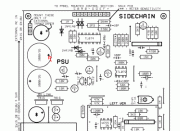MartyMart
Well-known member
I'm having a hard time following that photo, it's all cream covered wires and
what's all that "twisted pairs" wiring !! ( looks like too many wires there )
Sorry, the Amveco data seems pretty direct, if you are following that then
you should have an AC voltage on the secondaries of about 21V - as there's
no loading on it yet.
Secondaries are red&brown tied together for "0" volts and the green and blue
wires should have about 21v AC each, on them.
Do you have a good "ground" to the case on the primary side from the IEC socket?
Another check, Primary side wires are much thicker than the secondary wires on all
the toroids that I have .... ?? could that amveco colour code be reversed and therefore
you're getting no voltage reading ?
MM.
what's all that "twisted pairs" wiring !! ( looks like too many wires there )
Sorry, the Amveco data seems pretty direct, if you are following that then
you should have an AC voltage on the secondaries of about 21V - as there's
no loading on it yet.
Secondaries are red&brown tied together for "0" volts and the green and blue
wires should have about 21v AC each, on them.
Do you have a good "ground" to the case on the primary side from the IEC socket?
Another check, Primary side wires are much thicker than the secondary wires on all
the toroids that I have .... ?? could that amveco colour code be reversed and therefore
you're getting no voltage reading ?
MM.



























![Soldering Iron Kit, 120W LED Digital Advanced Solder Iron Soldering Gun kit, 110V Welding Tools, Smart Temperature Control [356℉-932℉], Extra 5pcs Tips, Auto Sleep, Temp Calibration, Orange](https://m.media-amazon.com/images/I/51sFKu9SdeL._SL500_.jpg)








